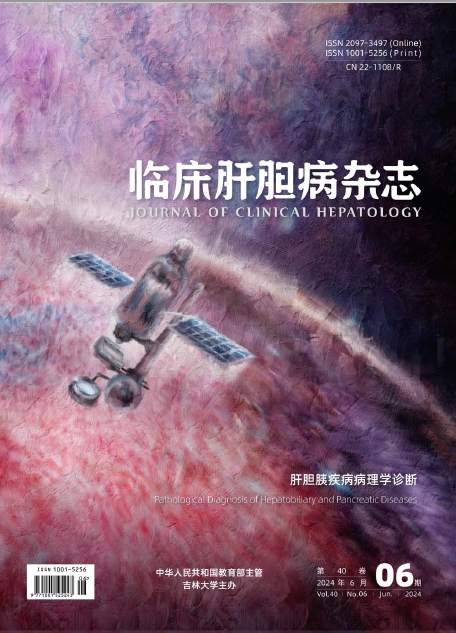| [1] |
YOUNOSSI Z, ANSTEE QM, MARIETTI M, et al. Global burden of NAFLD and NASH: Trends, predictions, risk factors and prevention[J]. Nat Rev Gastroenterol Hepatol, 2018, 15( 1): 11- 20. DOI: 10.1038/nrgastro.2017.109. |
| [2] |
ESLAM M, NEWSOME PN, SARIN SK, et al. A new definition for metabolic dysfunction-associated fatty liver disease: An international expert consensus statement[J]. J Hepatol, 2020, 73( 1): 202- 209. DOI: 10.1016/j.jhep.2020.03.039. |
| [3] |
LIN S, HUANG JF, WANG MF, et al. Comparison of MAFLD and NAFLD diagnostic criteria in real world[J]. Liver Int, 2020, 40( 9): 2082- 2089. DOI: 10.1111/liv.14548. |
| [4] |
KIM D, KONYN P, SANDHU KK, et al. Metabolic dysfunction-associated fatty liver disease is associated with increased all-cause mortality in the United States[J]. J Hepatol, 2021, 75( 6): 1284- 1291. DOI: 10.1016/j.jhep.2021.07.035. |
| [5] |
NGUYEN VH, LE MH, CHEUNG RC, et al. Differential clinical characteristics and mortality outcomes in persons with NAFLD and/or MAFLD[J]. Clin Gastroenterol Hepatol, 2021, 19( 10): 2172- 2181. e 6. DOI: 10.1016/j.cgh.2021.05.029. |
| [6] |
RINELLA ME, LAZARUS JV, RATZIU V, et al. A multisociety Delphi consensus statement on new fatty liver disease nomenclature[J]. J Hepatol, 2023, 79( 6): 1542- 1556. DOI: 10.1016/j.jhep.2023.06.003. |
| [7] |
YOUNOSSI ZM, RINELLA ME, SANYAL AJ, et al. From NAFLD to MAFLD: Implications of a premature change in terminology[J]. Hepatology, 2021, 73( 3): 1194- 1198. DOI: 10.1002/hep.31420. |
| [8] |
LIU ST, SU KQ, ZHAO CL, et al. Research advances in medical treatment of metabolic associated fatty liver disease[J]. J Clin Hepatol, 2021, 37( 4): 947- 950. DOI: 10.3969/j.issn.1001-5256.2021.04.048. |
| [9] |
HARRISON SA, ALLEN AM, DUBOURG J, et al. Challenges and opportunities in NASH drug development[J]. Nat Med, 2023, 29( 3): 562- 573. DOI: 10.1038/s41591-023-02242-6. |
| [10] |
CHALASANI N, YOUNOSSI Z, LAVINE JE, et al. The diagnosis and management of non-alcoholic fatty liver disease: Practice guideline by the American Gastroenterological Association, American Association for the Study of Liver Diseases, and American College of Gastroenterology[J]. Gastroenterology, 2012, 142( 7): 1592- 1609. DOI: 10.1053/j.gastro.2012.04.001. |
| [11] |
SHEKA AC, ADEYI O, THOMPSON J, et al. Nonalcoholic steatohepatitis: A review[J]. JAMA, 2020, 323( 12): 1175- 1183. DOI: 10.1001/jama.2020.2298. |
| [12] |
JIANG TT, SUN FF, ZENG Z, et al. Progress on metabolic associated fatty liver disease related liver cancer[J/OL]. Chin J Liver Dis(Electronic Version), 2022, 14( 3): 14- 17. DOI: 10.3969/j.issn.1674-7380.2022.03.004. |
| [13] |
|
| [14] |
ZHAO XY, KONG YY, ZHAO XY, et al. Risk factor analysis of significant liver fibrosis in the non-obese non-alcoholic fatty liver disease patients[J]. J Clin Exp Med, 2022, 21( 14): 1497- 1500. DOI: 10.3969/j.issn.1671-4695.2022.14.011. |
| [15] |
HUANG SC, SU HJ, KAO JH, et al. Clinical and histologic features of patients with biopsy-proven metabolic dysfunction-associated fatty liver disease[J]. Gut Liver, 2021, 15( 3): 451- 458. DOI: 10.5009/gnl20218. |
| [16] |
European Society for Paediatric Gastroenterology Hepatology and European Association for the Study of the Liver and European Association for the Study of the Liver(EASL) Oboca. Diagnosis of fatty liver in children should occur in parallel to investigation for other causes of liver disease[J]. Lancet Gastroenterol Hepatol, 2023, 8( 7): 598- 600. DOI: 10.1016/S2468-1253(23)00100-0. |
| [17] |
|
| [18] |
YOUNOSSI ZM, HENRY L, BUSH H, et al. Clinical and economic burden of nonalcoholic fatty liver disease and nonalcoholic steatohepatitis[J]. Clin Liver Dis, 2018, 22( 1): 1- 10. DOI: 10.1016/j.cld.2017.08.001. |
| [19] |
GOLABI P, OTGONSUREN M, DE AVILA L, et al. Components of metabolic syndrome increase the risk of mortality in nonalcoholic fatty liver disease(NAFLD)[J]. Medicine, 2018, 97( 13): e0214. DOI: 10.1097/MD.0000000000010214. |
| [20] |
HUANG JF, OU WJ, WANG MF, et al. MAFLD criteria guide the subtyping of patients with fatty liver disease[J]. Risk Manag Healthc Policy, 2021, 14: 491- 501. DOI: 10.2147/RMHP.S285880. |
| [21] |
FRITH J, JONES D, NEWTON JL. Chronic liver disease in an ageing population[J]. Age Ageing, 2009, 38( 1): 11- 18. DOI: 10.1093/ageing/afn242. |
| [22] |
ADAMS LA, LYMP JF, SAUVER J ST, et al. The natural history of nonalcoholic fatty liver disease: A population-based cohort study[J]. Gastroenterology, 2005, 129( 1): 113- 121. DOI: 10.1053/j.gastro.2005.04.014. |
| [23] |
FRITH J, DAY CP, HENDERSON E, et al. Non-alcoholic fatty liver disease in older people[J]. Gerontology, 2009, 55( 6): 607- 613. DOI: 10.1159/000235677. |







 DownLoad:
DownLoad: